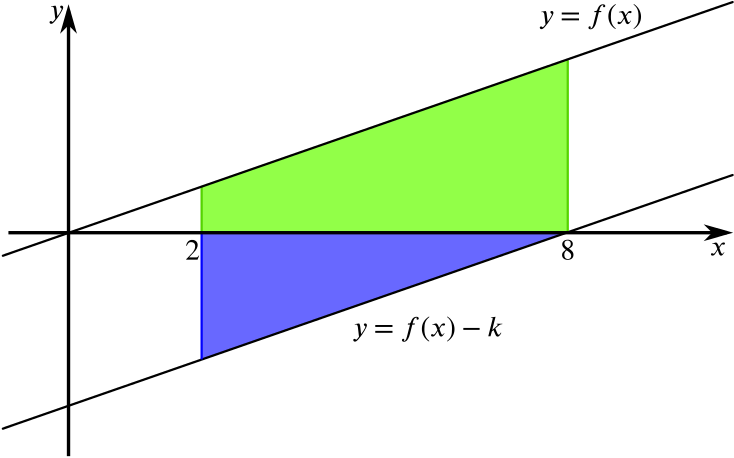In the diagram below \(f(x)\) is a linear function.
The area of the green shaded region (above the \(x\)-axis) is \(12\) square units.

What is the area of the blue shaded region (below the \(x\)-axis)?
There’s more than one way in which we could calculate the area of the blue triangle. For most methods that we might consider we will need to identify the value of \(y\) when \(x=2\) (let’s call this \(y_1\)) and when \(x=8\) (let’s call this \(y_2\)).
How do we know that identifying these two values, \(y_{1}\) and \(y_{2}\), is a good strategy and will provide enough information to solve the problem?
In order to identify these two values we might begin by writing down an equation involving them. This could be the area of the green trapezium which can be written as \[12 = \frac{1}{2}(y_{1} + y_{2}) \times 6.\]
Rearranging this we find that \[\begin{equation} \label{eq:1} y_{1}+y_{2} = 4. \end{equation}\]In order to identify the unique values of \(y_1\) and \(y_2\) we now need a second equation containing these two unknowns.
Notice that we could have obtained this second equation by considering similar triangles instead.

The purple and yellow triangles are similar and related by a linear scale factor of \(4\). Therefore \(y_{2} = 4y_{1}\).
Solving equations \(\eqref{eq:1}\) and \(\eqref{eq:2}\) simultaneously we find that \(y_{1} = \dfrac{4}{5}\) and \(y_{2} = \dfrac{16}{5}\).
Now, the area of the blue triangle can be calculated directly if we first calculate the perpendicular height of the blue triangle as \(y_2 - y_1 = \dfrac{16}{5} - \dfrac{4}{5} = \dfrac{12}{5}\). Then we can calculate the area of the blue triangle as \[\frac{1}{2} \times 6 \times \frac{12}{5} = \frac{36}{5} \textrm{ square units}.\]
Notice that the area of the blue triangle is less than \(12\) square units. Is this what you expected?
It is also worth noting that, whilst we didn’t need it in order to solve the problem, we now know that \[y = f(x) = \dfrac{2}{5} x\] and that the translated line has equation \[y = f(x) - k = \frac{2}{5}x - \frac{16}{5},\] which can also be written as \[y = \dfrac{2}{5}(x - 8).\]
An alternative approach
We can also solve the problem without working out the values of \(y_1\) and \(y_2\) explicitly.
Since the lines are a distance of \(k\) apart, we have \(y_2=k\). By similar triangles, as above, \(y_1=\frac14 y_2=\frac14 k\).
Therefore the green trapezium, which has ‘height’ \(6\) and parallel sides of \(k\) and \(\frac14 k\), has area \[\frac12\times 6(k+\tfrac14k)=3\times \frac54 k.\]
The blue triangle also has ‘height’ \(6\) but its base is \(k-y_1=\frac34 k\). Therefore its area is \[\frac12\times 6\times \tfrac34k=3\times \frac34 k.\]
Therefore the ratio of the green area to the blue area is \(5\) to \(3\), and so the blue area is \[\frac35\times 12=\frac{36}{5}.\]
Reflection
At first sight, it may not have looked as though there was enough information to solve the problem. Why was it possible?
How can you generalise the problem?

